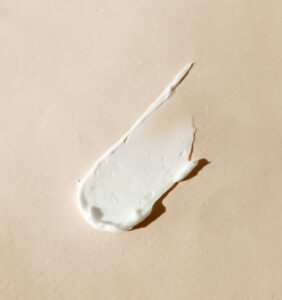Does Sunscreen Clog Pores? Scientific Guide for Acne-Prone Skin
Sunscreen is one of the most crucial elements of any skincare routine alongside cleanser and moisturiser. It forms a robust defence against the sun’s harmful ultraviolet (UV) radiation to help prevent sun damage, skin cancer, fine lines, and dark spots. However, for individuals with acne-prone skin, the fear of wondering ‘Does sunscreen clog pores?’ can be a daunting concern.
In this comprehensive guide, we will explore the intricate world of sun protection and its effects on acne-prone skin.
Read on to discover the science behind chemical and physical (or mineral) sunscreens. Analyse their active ingredients and particle sizes relative to pore-clogging. Understand which factors to look for in a non-pore clogging sunscreens, such as water-based formulae and non-comedogenic ingredients.

Section I: Understanding Types of Sunscreen: Chemical vs. Physical
To comprehend sunscreen’s effects on acne-prone skin, we must first distinguish between the two major types: chemical and physical (mineral) sunscreens.
We can then investigate the pore-clogging factors across both sunscreen types, particularly in respect to photostability and particle size.

Chemical Sunscreens
Chemical sunscreens are also known as organic sunscreens. They are formulated to protect the skin from the harmful effects of ultraviolet (UV) radiation from the sun.
Unlike physical sunscreens that reflect UV rays, chemical sunscreens work by absorbing UV radiation before it can penetrate the skin and cause damage.
ULTRAVIOLET (UV) RADIATION
- UVA (wavelength 320-400nm) accounts for 95% of the solar UV radiation that reaches the Earth’s surface. This type of radiation is notorious for penetrating deepest into the skin. This can contribute to skin cancer through causing indirect DNA damage.
- UVB (wavelength 290-320nm) accounts for 5% of the solar UV radiation that reaches the Earth’s surface. UVB contributes to skin cancer and causes direct DNA damage.
How Chemical Sunscreens Work

Absorptive Properties
In chemical sunscreens, active ingredients like avobenzone and octisalate absorb and neutralise UVA rays and UVB rays through photo-protective absorption. Each distinct active ingredients has specific absorption properties and may target different wavelengths of UV radiation.
When UV radiation strikes these compounds, their electrons are excited to higher energy states, effectively absorbing the UV energy. This absorption process prevents the harmful UV energy from reaching the skin’s DNA. Therefore, chemical sunscreens mitigate the risk of skin damage, sunburn and skin cancer. The absorbed energy is then safely dissipated as heat, offering broad-spectrum protection against both UVB and UVA rays.
Does Chemical Sunscreen Clog Pores?
Chemical sunscreens are typically lightweight and easy to apply for everyday use. However, they have faced criticism for their potential to clog pores, especially in individuals with sensitive or acne-prone skin.
How does chemical sunscreen clog pores?

The active ingredients in chemical sunscreens penetrate the epidermis and interact with skin lipids and sebum. This occurs due to their lipophilic (fat-attracting) nature. For individuals with sensitive or acne-prone skin, this interaction can exacerbate existing skin conditions. It may promote inflammation and the accumulation of sebum and dead skin cells within the pores. Acne breakouts and skin congestion can then potentially manifest. Therefore, it can be more common for chemical sunscreens to clog pores.
However, some chemical UV filters are lighter and less likely to clog pores compared to others. Factors like the specific formulation, concentration of the chemical UV filters, and individual skin sensitivities are also relevant. Always look for sunscreens with ‘non-comedogenic’ on their labels.

Physical Sunscreens
The inorganic UV filters in physical sunscreens (also known as mineral sunscreens) create a physical barrier on the skin’s surface. They reflect and scatter UV radiation whilst acting like a shield on top of the skin rather than being absorbed.
Physical UV filters are photo-stable by nature because these minerals do not undergo chemical reactions when exposed to UV radiation.
Titanium Dioxide and Zinc Oxide
Two common UV filters that offer strong, broad-spectrum sun protection are zinc oxide and titanium oxide.
ZnO offers broad-spectrum protection against both UVA and UVB radiation. This is due to its broader absorptive spectrum compared to TiO2. However, ZnO is more effective in protecting against UVA radiation. Meanwhile, TiO2 is more effective in protecting against UVB radiation.
The combination of these compounds in a sunscreen formula ensures powerful broad-spectrum UV protection with enhanced photo-stability.

Physical sunscreens are less likely to clog pores compared to chemical sunscreens. This is due to the relatively larger molecular size of their active ingredients.
However, it is important to note their specific particle size in physical sunscreens as this affects their pore-clogging capabilities.
How Particle Size Affects Pore-Clogging
A key distinction across types of physical sunscreens is the molecular (or particle) size of key active ingredients. These include regular-sized (micronised) particles and nano-sized particles.
Notably, titanium dioxide and zinc oxide exist in both micronised and nano- forms.
Micronised Particles

Micronised particles are particles that have been reduced in size to to be smaller than conventional bulk materials. However, they are still larger than nanoparticles. Their size is typically in the micrometre (micron) range. They are often used in traditional mineral sunscreens.
This macroparticulate (or bulk) form of these particles offer several benefits regarding pore clogging. These larger particles are less likely to penetrate deeply into the skin. Therefore, they are less likely to clog pores or exacerbate acne. The larger size of micronised particles allows them to sit on the surface of the skin. Here, they form a physical barrier that reflects and scatters UV radiation.
Their reduced surface area-to-volume ratio limits their reactivity and potential to penetrate barriers in the skin. Therefore, this physical sunscreen barrier helps to protect the skin without interfering with the skin’s natural processes or causing pore congestion. Additionally, the larger size of micronised particles results in more predictable light scattering and absorption properties. This particularly ensures more consistent and effective UV protection.
Nano-sized Particles
Conversely, nano-sized particles are engineered to be very small in the range of 1 to 100 nanometres (nm) in diameter. This is significantly smaller their micronised counterparts. These are often used in mineral sunscreens particular to make the product more cosmetically elegant. They tend to create a less noticeable white cast. This is due to reduced scattering of light from reduced surface area and in accordance with Mie scattering principles.
Nanoparticles and Pore-Clogging Risk
These nanoparticles can exacerbate acne in individuals with sensitive or acne-prone skin. Nanoparticles have the ability to penetrate deeper into the skin, increasing the risk of pore congestion and leading to breakouts. Specifically, they have a higher surface area-to-volume ratio compared to larger particles. This increases their reactivity and potential to penetrate biological barriers such as the skin.

Opt for larger, micronised particles when selecting sunscreen to reduce your pore-clogging risk.
Physical Sunscreen with Micronised, Non-Clogging Particles

Sunscreen SPF 46 Oil Free with Zinc Oxide and Octinoxate
Elta MD are renowned for their broad range of (professional?) sunscreens developed by…
The Elta MD UV Clear Broad Spectrum 46 Face Sunscreen is specifically designed for skin types prone to acne, rosacea and hyperpigmentation.
The sunscreen is:
- formulated with 9% transparent micronised zinc oxide;
- oil-free
- non-comedogenic
- fragrance-free and paraben-free
- anti-oxidant rich and contains niacinamide (Vit. B3), hyaluronic acid and lactic acid to help calm and protect sensitive skin.
However their sunscreens may leave a white cast. This makes it ideal for very fair skin tones or to layer beneath makeup. Otherwise, Elta MD also offers tinted sunscreens.

Section II: Factors to Help Prevent Pore Clogging
There are important factors that individuals with oily or sensitive skin who are prone to clogged pores should consider in a sunscreen.
Let us now delve into how non-comedogenic, oil-free, and fragrance-free sunscreens help to protect against clogging pores.
| Sunscreen Labels: Avoid These | Sunscreen Labels: Look For These |
|---|---|
| No mention of non-comedogenic | Non-comedogenic |
| Oil-based | Oil-free or water-based |
| Synthetic fragrance | Fragrance-free |
| Emollients, thickeners | Humectants |
| Antioxidants |
Non-Comedogenic Labels
Non-comedogenic
Individuals with acne-prone still should always search for products including sunscreen products that are labelled as non-comedogenic. Non-comedogenic products are formulated to minimise pore-clogging ingredients, reducing the risk of acne breakouts and maintain clear, healthy skin.
Conversely, comedogenic ingredients have a tendency to block or clog pores. Common comedogenic ingredients can include mineral oil, coconut oil, cocoa butter, and some forms of dimethicone. These ingredients can exacerbate acne particularly in individuals with acne-prone skin, compared to those with normal or dry skin types.
How comedogenic ingredients clog pores
1. Thickening of sebum
The molecular structure of some comedogenic ingredients, such as long-chain fatty acids found in certain esters, can encourage sebum to become thicker. This is because these molecules can bind to sebum and alter its physical composition. The result is compounds that are more viscous or solid at body temperature. The increased viscosity of this sebum can hinder its flow and expulsion from the sebaceous glands.

Consequently, sebum, dead skin cells and bacteria can become trapped and contribute to pore blockages within the hair follicle. Comedones can then form as non-inflammatory acne lesions like whiteheads and blackheads. Their accumulation can result in the development of inflammatory acne lesions, including papules, pustules, and cysts.
2. Increased sebum production

Comedogenic ingredients can stimulate the sebaceous glands to produce more sebum than normal.
This can occur through interacting with hormone receptors on sebaceous glands. The effect is to mimic or enhance the effects of androgens like testosterone that regulate the sebaceous glands.
Sebum production is tightly regulated by hormonal signals to keep the skin hydrated, protect it from external factors, and regulate temperature. However, when these signals are amplified or disrupted by comedogenic ingredients, the sebaceous glands respond by producing an excess of sebum.
Overproduction of sebum is particularly problematic for individuals with acne-prone skin. Excess sebum provides an environment conducive to the growth of acne-causing bacteria, particularly Propionibacterium acnes.
Water-based Sunscreens and Humectants
Water-based
Water-based products, from sunscreens to moisturisers, are a strongly recommended option for acne-prone individuals. They exhibit a lightweight texture that facilitates rapid absorption for a matte finish. Their lighter formulations that are less occlusive compared to oil-based products, allowing the skin to ‘breathe’ more freely.
Water molecules, due to their polar nature, tend to interact more readily with other polar molecules as opposed to molecules with non-polar bonds like oils. This means they do not exacerbate the skin’s natural oil levels. Therefore, water-based products are less likely to exacerbate pore congestion or acne formation in individuals with oily or acne-prone skin.
Oil-free
It’s essential for individuals with oily skin to identify which specific ingredients or products work best for their skin type through trial and observation.
Some may find that certain non-comedogenic oils, such as jojoba oil or squalane, are well-tolerated and beneficial for their skin. Meanwhile, others may prefer oil-free formulations to minimise shine and reduce the risk of breakouts.
To minimise your pore-clogging risk, try using oil-free products including sunscreen that displays ‘oil-free’ on their label.
Humectants
Humectants, like glycerin and hyaluronic acid, attract and retain moisture from the environment or the deeper layers of the skin. They help to hydrate and moisturise the skin by drawing water molecules into the skin’s outer layers, improving overall hydration and suppleness.
In non-comedogenic, water-based sunscreens, humectants play a crucial role in providing lightweight hydration without adding additional oils to the skin’s surface that may clog pores. This helps maintain the integrity of the skin barrier and prevent moisture loss without increasing oiliness. This makes water-based sunscreens with humectants ideal for individuals seeking effective sun protection without pore-clogging, or exacerbating oily or acne-prone skin.

Leave A Comment